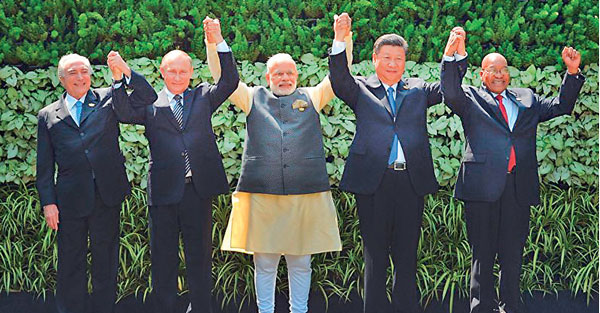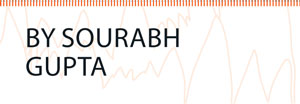02 Nov 2016 - {{hitsCtrl.values.hits}}

BRICS (Brazil, Russia, India, China and South Africa) has established itself as a supple entente of  independent-minded rising powers, organised as a mutual support network committed to assisting member countries’ rise in the international economic order. But as China prepares to guide BRICS into its second decade as its current chairperson, the grouping must graduate beyond its development finance orientation.
independent-minded rising powers, organised as a mutual support network committed to assisting member countries’ rise in the international economic order. But as China prepares to guide BRICS into its second decade as its current chairperson, the grouping must graduate beyond its development finance orientation.
BRICS must evolve into the most important emerging market economy forum in order to push for an overhaul of the international monetary system — a system whose architecture is failing to keep pace with dynamic changes in the shape and scale of cross-border finance. In a reprise of the 1920s and 1930s, large short-term capital flows are transmitting economic upheaval across borders, but the existing monetary order is yet again failing to provide systemic liquidity management tools to cope with these episodes of extreme volatility. Even as the system is awash with liquidity, there is a palpable shortage of high-quality or safe assets that are widely used in cross-border transactions.
While the dollar remains the system’s principal reserve asset, US authorities are displaying little interest in mitigating capital flow volatility, short of an extreme systemic crisis. The Federal Reserve’s unwillingness to countenance credit or legal risk has stalled promising ideas to expand the global liquidity safety net for emerging economies. These include an International Monetary Fund (IMF) centred multilateralisation of currency swaps, US Federal Reserve-central bank bilateral swap arrangements and cross-border collateralised lending arrangements. The Federal Reserve won’t engage in such operations for lack of guarantees that potential losses on swap transactions will be indemnified. Besides, its mandate is domestic. The US Treasury, meanwhile, will not allow such financial resources to flow to or be provided by the IMF.
Modernising the IMF’s financing facilities to adapt to today’s capital flow realities has not fared much better. The gap between its original mandate — temporary lending to enable countries to tide over illiquidity-driven balance of payments contingencies — and the tools at its disposal keeps widening. The European Stability Mechanism has armed itself against capital flow induced balance of payments crises with a wide-ranging and sophisticated financial assistance toolkit. This includes temporary loans for macroeconomic adjustment, very short-term precautionary credit lines, the facility to make primary and secondary market purchases of debt securities, as well as loans and guarantees for direct and indirect bank capitalisation. Yet, the key shareholders deny the IMF almost all these tools behind the façade of moral hazard and defer any discussion on loss-sharing frameworks.
Very Short-Term Liquidity Line
Going forward, the BRICS should press the IMF to introduce a ‘Very Short-Term Liquidity Line’ that can disburse the entire amount of approved access upfront to pre-qualified countries and with no ex post policy conditionality attached. The BRICS countries should concurrently convert, and enlarge, their Contingent Reserve Arrangement into an Emerging Market Crisis Prevention Fund that is large enough to lean against during sharp swings — and self-fulfilling market panics — in an emerging market index of targeted bond prices such as EMBI+ (Emerging Market Bond Index Plus).
Over the medium-term, the BRICS should aim to institute a broadening of the existing Special Drawing Rights (SDR) arrangements within the monetary system, making their issuance automatic and regular. They should also establish modalities to enable the IMF to guarantee SDR allocations to central banks on short notice or to borrow from capital markets to fund liquidity provision operations during periods of heightened market stress. The IMF-provided guarantees of new sovereign debt issuance and automatic purchase of secondary market bonds of pre-qualified countries should also be put on the table.
Regional financing arrangements, such as the BRICS Contingent Reserve Arrangement, could offer to bear a first-loss tranche during such operations so as to cushion the IMF’s second layer financing from potential capital losses. As a recent entrant to the SDR club with a strong balance of payments position, the People’s Bank of China should support broader usage of the IMF’s ‘designation mechanism’ by volunteering to freely swap renminbi for SDRs while bearing any depreciation risk on its own balance sheet.
In the long-term, the BRICS countries must aim to return the IMF’s machinery for collaboration on global monetary problems to its formative Bretton Woods design as a non-politicised, technocratic — not shareholder-run — institution. Its crisis prevention operations should tilt in the direction of automaticity rather than discretion and conditionality. The IMF’s single greatest intellectual failing at the time of its founding — the inability to factor the role played by private capital movements — must also be remedied by amending its Articles of Agreement to grant the IMF explicit jurisdiction over members’ capital accounts, including over source country flows.
The promotion of international financial stability, like infrastructure development, is a global public good. The incessant delay by the World Bank to set up an infrastructure development fund was a driving motive to create the Asian Infrastructure Investment Bank. With the United States unwilling, or unable, to underwrite international financial stability in the post-bank-intermediated age of global finance, China’s BRICS chairpersonship should create an International Financial Architecture Working Group and focus attention on useful designs for systemic liquidity management within the global monetary order.
(East Asia Forum)
(Sourabh Gupta is a Resident Senior Fellow at the Institute for China–America Studies (ICAS) in Washington, DC)
10 Jan 2025 3 minute ago
10 Jan 2025 10 minute ago
10 Jan 2025 26 minute ago
10 Jan 2025 41 minute ago
10 Jan 2025 46 minute ago